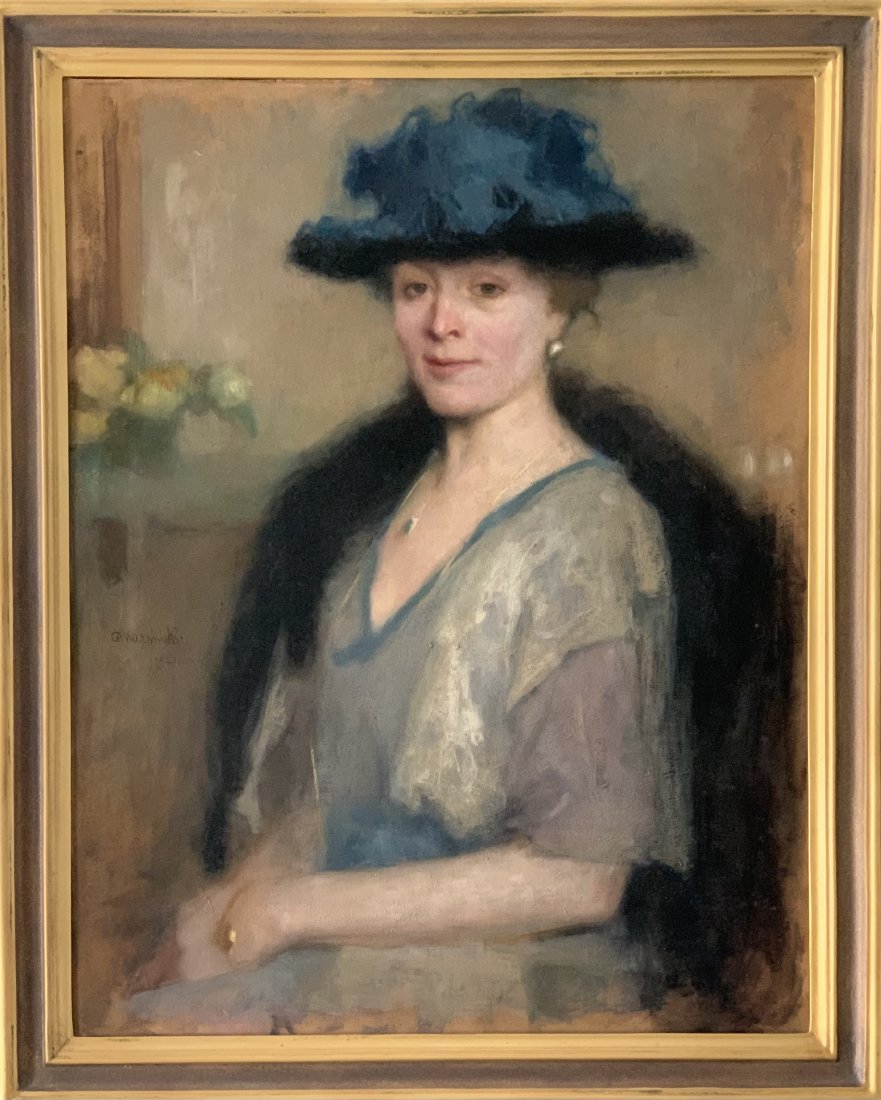Description:
Alfons Karpiński (1875-1961)
studied at the Krakow School of Fine Arts, the Munich Academy, the Vienna Academy, the Académie Willi, and the Académie Colarossi in Paris. He was a drawing teacher at the Higher Courses for Women named after Braniecki. He exhibited his works all over the world and was an incredibly prolific artist. He painted rural, genre, still life, and portrait scenes that dominated his creativity.
The description of the painting: From beneath a blue round hat, sleepy, slightly veiled eyelids look out at us. They seem tired and alert at the same time. The slim face of the model, with its prominent cheekbones and sharp, straight nose, is expressive and focuses attention on itself. The thin lips curve in a delicate, slightly mocking smile, revealing a sense of humor. The upright, somewhat stiff pose of the model does not express embarrassment, but rather a certain haughtiness, pride or determination of the person being portrayed. The dark fabric thrown nonchalantly over the model’s right shoulder emphasizes this authority. The status of an elegant woman of the upper class is also reinforced by the clearly marked jewelry, earrings, necklaces and bracelet. The woman is dressed in a flowing, comfortable-looking dress, painted with muted yellows, blues and pinks. The blurry background blurs and does not show too many details, only a fragment of a vase with yellow flowers on a greenish shelf.
Karpiński supported himself for most of his life by his painting. Portraits, particularly female ones, were often ordered from him, providing him with almost permanent employment. His paintings made women mysterious, interesting, attractive and beautiful, so many dreamed of having their portrait painted by the artist. He was also often commissioned to paint still lifes, which usually depicted vases filled with flowers painted with a muted color palette. The elegant sophistication of these decorative paintings made them a popular choice for salons.
At the beginning of his creativity, Karpiński followed a different artistic path. At that time his paintings depicted the colorful Polish countryside in a very expressive, realistic way. This particular matteness, pastel colors, blurring of outlines and striving for synthesis appeared in his works only after his stay in Paris in 1907-1912. Later he himself said that Paris had a decisive influence on his creativity. One can look for the source of this change in the specific atmosphere of individualism and artistic pursuit that prevailed in the French capital at the time. It is difficult, however, to ignore the references to specific artists with whom Karpiński came into contact. Olga Boznańska, whom he met personally and bought pictures from for his collection, had a great influence on his art. She was painting with a dry brush on cardboard to get a matt effect and blurring, which very much resembles Karpiński’s search, also using this technique. Like her, the artist gradually strove for greater synthesis, simplification, quieting of unnecessary elements in the image and extraction of the essence of the portrayed person, reaching into their inner self.
Looking at Karpiński’s portrait, we will find all these mentioned features, special care to convey the character of the person portrayed. However, while Boznańska focused primarily on the truth of the painted model, Karpiński, extremely sensitive to beauty, also focused on finding it in the person portrayed, both by emphasizing the outfit, the texture of the fabrics, and also by highlighting accessories, small details that emphasize the elegance and status of the portrayed people.


